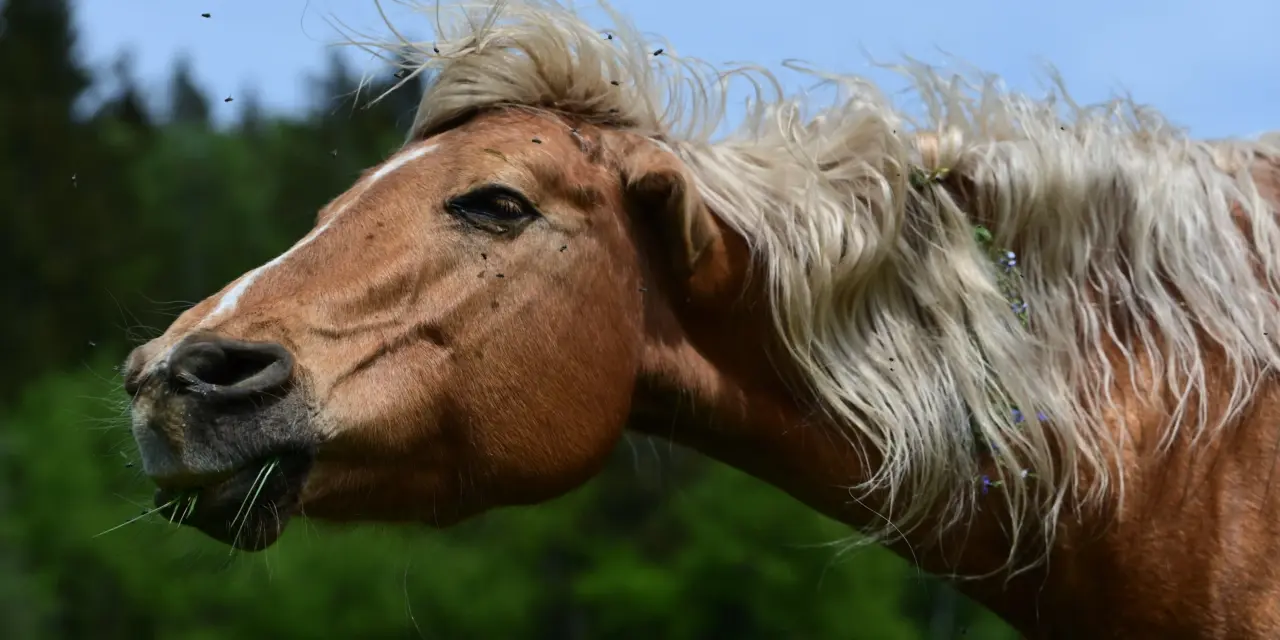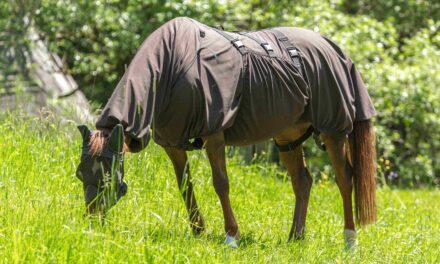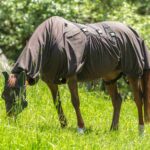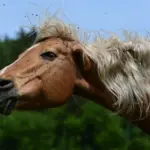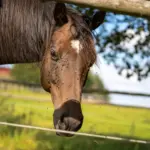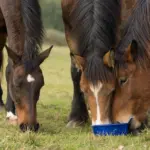Why wild horses manage without fly rugs – and what we can learn from it
Key Points at a Glance
- Natural defences: A horse’s mane, forelock, tail – and sometimes a dense summer coat – serve as built-in protection against insects
- Breed-related weaknesses: Modern horse breeds often have less natural protection than their wild counterparts
- Movement matters: Horses in motion attract fewer insects – stabling can increase insect problems
- Skin twitch reflex: Horses can shake off insects through involuntary skin twitches
- Smart behaviour: Seeking shade and choosing strategic spots are natural defence strategies
For millions of years, horses survived in the wild—without any human help and certainly without fly rugs. And yet, they were exposed to the same annoying insects as today—often in even greater numbers. So how did they manage? The answer lies in their sophisticated natural defence mechanisms—many of which are no longer fully functional in our modern domestic horses.
Horses are, by nature, perfectly equipped
Nature’s own fly deterrents: mane and forelock
The long, thick forelock of a wild horse acts like a natural shield over its eyes. While grazing, these hairs are in constant motion, making it nearly impossible for flies to settle on the sensitive eye area. The mane serves a similar function along the neck – exactly where horses sweat the most in the heat, attracting insects.
This natural design is so effective that even a light breeze sets the hairs in motion, creating continuous defence. What may look like a wild hairstyle to us is actually a highly developed protection system.
The tail – more than just decoration
The horse’s tail is far more than just a visual feature. It acts as a flexible, precise insect repellent, capable of reaching the flanks and belly. Wild horses often have especially long, thick tails that extend nearly to the ground. This length is crucial— the longer the tail, the larger the area of the body that can be effectively protected.
If you observe horses out on pasture, you’ll notice that their tails are almost never still. Even while dozing or grazing calmly, the tail keeps moving—a reflex action that doesn’t require conscious control. When the tail strikes the body, it fans out effectively, sweeping away bothersome insects across a wide area.
The underestimated skin reflex
One often overlooked aspect of a horse’s natural insect defence is the so-called skin twitch reflex. Horses can reflexively twitch their skin at nearly any point on their body when an insect lands on them. This involuntary reaction works much like our blink reflex—instantaneous and without conscious thought. Since it’s not an active muscle movement, the skin twitch reflex even functions when the horse is sedated.
This mechanism is especially important in areas of the body that neither mane nor tail can reach, which is why the skin twitch reflex is particularly strong along the flanks. The subtle muscle movements just beneath the skin can drive away even the most persistent horsefly.
What human intervention has changed
Aesthetics over function
The reality in modern horse stables looks quite different. Selective breeding has drastically reduced the natural protective hair in many breeds. Warmblood horses are expected to look elegant and athletic – lush manes and long forelocks interfere with the desired appearance.
These aesthetic choices have practical consequences. A forelock trimmed to just a hand’s width can no longer effectively shield the eyes. A thinned-out mane, additionally clipped to “show length,” loses its function as a barrier against insects. The price for a “tidy” appearance is the loss of natural protection.
Short tails, big problems
Trimming the tail to hock length—a practice still popular among sport riders—has particularly serious consequences. While it may look tidy and athletic, it robs the horse of its most important natural defence against insects on the body. A shortened tail simply can’t reach the belly or flanks properly—exactly the areas that biting insects find most attractive.
Constant movement is an effective insect-avoidance strategy
Always on the move
Wild horses rarely stay in one place for long. Their constant movement isn’t just about searching for food—it also serves as an effective defence against insects. Flies and mosquitoes have a much harder time landing on a moving target than on a horse that’s standing still.
Strategic choice of location
In the wild, horses can choose their own location. They instinctively avoid damp areas like swamps or ponds where mosquitoes breed and seek shelter in the shade during the hottest part of the day. Not only is it cooler there, but it’s also less attractive to horseflies, which are most active in direct sunlight.
The reality in many stables looks quite different
Our domestic horses don’t have that freedom of choice. They stay where we’ve put the fence—often without shade, sometimes near standing water like puddles or drainage ditches, or even right next to the muck heap, which practically attracts flies. They’re turned out during the hottest part of the day on pastures with no trees or shrubs to offer shade, leaving them completely exposed to horseflies. In the evening, they return to their stables, where the next wave of flies is already waiting. Their natural behaviours for avoiding insects simply can’t be expressed in these conditions.
What we can learn from this
Understanding natural defense mechanisms should influence our decisions in horse management. Instead of ignoring evolution, we can support it:
- Trim mane and forelock for function rather than cutting them short
- Leave tails at their natural length wherever possible
- Provide opportunities for movement through larger pastures or paddock trail systems
- Ensure shaded areas are available during the midday heat
- Adjust turnout times to match the horses’ natural activity patterns
Nature has had millions of years to develop perfect solutions. Rather than replacing them entirely, we should seek to understand and support them—especially where modern horse keeping reaches its limits. A horse that can rely on its natural defence mechanisms will need far fewer artificial aids in the fight against bothersome insects.

